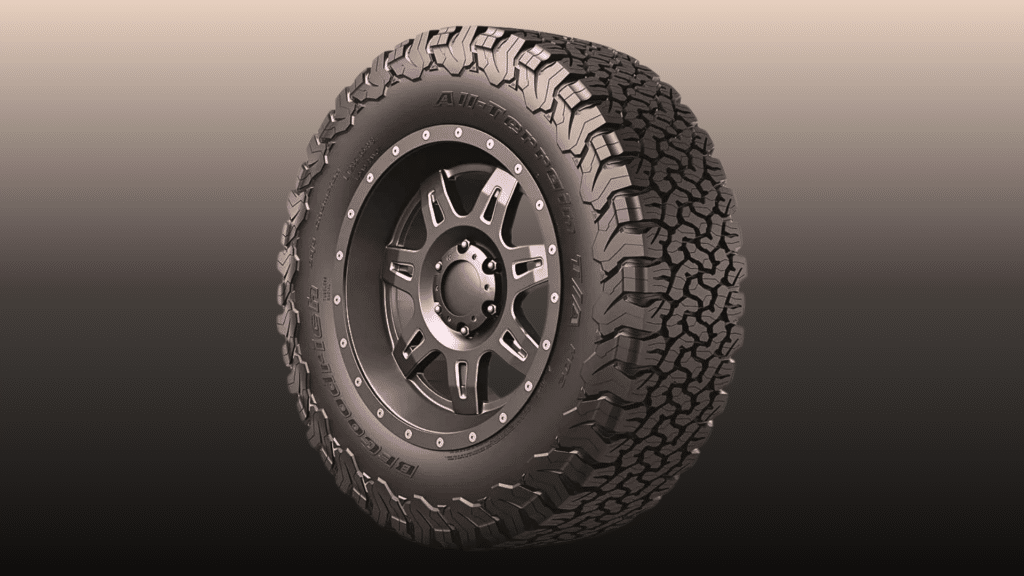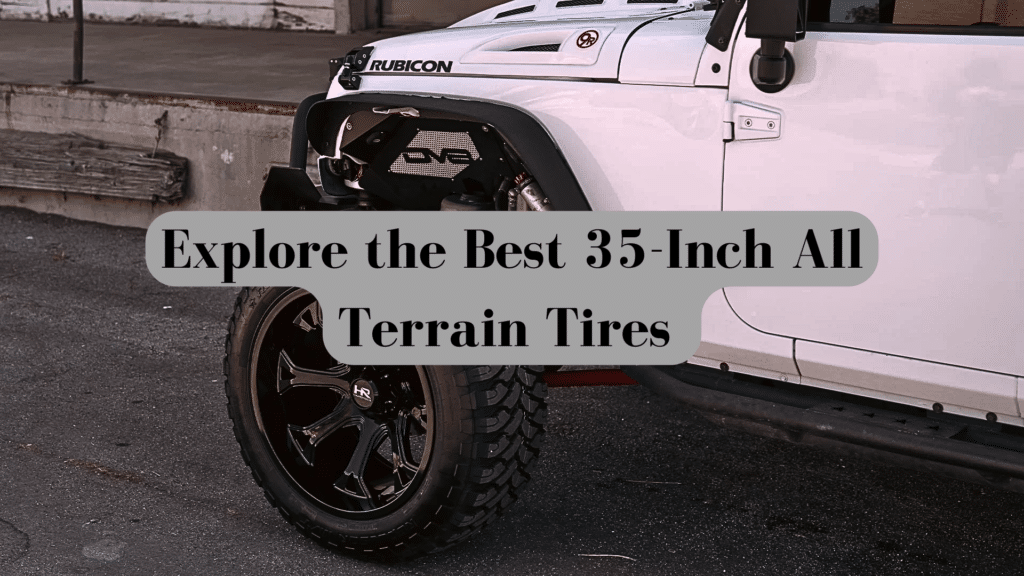Looking for the right 35-inch all-terrain tires for your truck or SUV?
Let me help you make a smart choice.
I’ve spent years testing these big, versatile tires on everything from muddy trails to city streets.
35-inch all-terrain tires give your vehicle extra ground clearance and grip, making them perfect for both off-road adventures and daily driving.
In this guide, I’ll show you:
- The top 35-inch all-terrain tire options
- What to look for when buying
- Installation tips and requirements
Let me save you time and money by sharing what I’ve learned through hands-on experience.
Key Features of 35 Inch Tires

Strong Build Quality
These tires are built tough.
Their thick rubber and sturdy internal structure help them last a long time, even on rough trails.
I’ve seen good ones handle sharp rocks and tree roots without damage.
Grip on Different Surfaces
You’ll get solid traction in most conditions. The deep tread patterns bite into:
- Wet grass and mud
- Loose gravel and rocks
- Packed snow and slush
- Sandy trails
Load Strength
The strong sidewalls can handle heavy loads.
This means you can load up your truck or SUV without worrying about tire flex.
Most 35-inch tires can carry 3,000 to 4,000 pounds per tire.
Road Comfort
I won’t sugarcoat it—these tires make more noise than regular street tires.
However, many newer models have special tread designs that reduce road noise.
You’ll feel some vibration, but it’s not bad enough to shake your coffee cup.
Pro tip: Check the speed rating before you buy.
Some 35-inch tires aren’t made for highway speeds, which could affect your daily drive.
Advantages of Choosing 35 Inch Tires
After years of testing, let me share the biggest benefits of 35-inch tires.
Better Off-Road Control
These tires help you tackle tough trails with confidence.
The wide footprint spreads out your vehicle’s weight, helping you float over soft sand and mud instead of sinking.
I’ve driven through spots that would stop smaller tires.
More Space Under Your Vehicle
With 35-inch tires, you’ll sit higher off the ground. This extra height lets you:
- Clear large rocks and logs
- Drive through deeper water
- Avoid scraping your undercarriage
- Handle steep angles better
Clean, Powerful Look
Big tires change the appearance of your truck or SUV.
They fill out your wheel wells nicely and give your vehicle a strong stance, making your ride stand out without looking overdone.
Works Well Everywhere
I love how these tires handle different conditions.
They work great on:
- Snowy winter roads
- Wet spring trails
- Hot summer highways
- Muddy fall paths
A Note on Fit: Make sure your vehicle can handle 35-inch tires.
You might need a lift kit or other modifications. I can help you determine what your ride needs.
Limitations of 35 Inch Tires
They Cost More
These tires aren’t cheap. You’ll pay about $250-400 per tire, sometimes more.
Plus, you’ll need to replace all four at once for even wear.
I’ve found that they also wear out faster than standard tires.
Gas Mileage Takes a Hit
Your fuel costs will go up. The extra weight and size make your engine work harder.
From my experience:
- City driving: Expect 2-3 MPG less
- Highway driving: About 1-2 MPG less
- Off-road: Even bigger drops in efficiency
Extra Parts Needed
You can’t just bolt these tires on and go. Most vehicles need:
- A lift kit ($500-2000)
- New gear ratios ($1000-2000)
- Bigger wheel wells
- Stronger brake lines
Weight Issues
Each tire is about 20-30 pounds heavier than stock. This extra weight:
- It puts more stress on your bearings
- It makes your brakes work harder
- Can wear out suspension parts faster
- It affects your steering feel
35 Inch Tires Compatibility with Different Vehicles
Let me help you figure out if these tires will fit your ride.
I’ve installed them on many vehicles and know what works.
Which Vehicles Can Use Them
These tires work best on:
- Full-size trucks (Ford F-150, Chevy Silverado, Ram 1500)
- Jeep Wranglers and Gladiators
- Large SUVs (Toyota 4Runner, Ford Bronco)
- Heavy-duty pickups
Required Changes
Most vehicles need extra work to fit 35s properly. Here’s what I typically see:
- 3-4 inch lift kit minimum
- Wider fenders or fender trimming
- New wheel backspacing
- Brake caliper modifications
Watch Out For These Issues
Before you buy, check these parts on your vehicle:
- Axle strength (some stock axles can’t handle the weight)
- Steering system limits
- Wheel well spaced
- Spare tire storage (the bigger tire might not fit)
Need specific details for your vehicle?
Tell me what you drive, and I’ll break down exactly what you’ll need to make 35s work.
Comparing 35 Inch Tires to Competitors
Let me show you how 35-inch tires compare to other sizes.
I’ve tested all these options personally and created this simple breakdown.
Size Comparison Table
| Feature | 33-Inch Tires | 35-Inch Tires | 37-Inch Tires |
|---|---|---|---|
| Cost Per Tire | $200-300 | $250-400 | $350-500 |
| Ground Clearance | 1.5″ less than 35s | Standard | 1″ more than 35s |
| Lift Kit Needed | 2-2.5 inches | 3-4 inches | 4-6 inches |
| Gas Mileage Loss | 1-2 MPG | 2-3 MPG | 3-4 MPG |
| Off-Road Use | Good | Better | Best |
| Daily Driving | Best | Good | Fair |
Top Brands and Their Best Features
| Brand | Best Feature | Price Range |
|---|---|---|
| BF Goodrich KO2 | Long-lasting | $280-320 |
| Nitto Terra Grappler | Quiet on roads | $260-300 |
| Toyo Open Country | Good in mud | $270-310 |
| Goodyear Wrangler | Works well in snow | $250-290 |
| Cooper Discoverer | Good value | $230-270 |
Tips for Maintaining and Maximizing the Life of 35 Inch Tires
Rotation and Alignment Schedule
Mark your calendar for these key services:
- Rotate tires every 5,000 miles
- Check alignment every 10,000 miles
- Switch tire positions if you see uneven wear
- Get balancing done with each rotation
Tire Pressure Matters
I check my pressure weekly. Here’s what I’ve found works:
- Street driving: 35-40 PSI
- Off-road use: 20-25 PSI
- Towing: Add 5 PSI to normal pressure
- Cold weather: Check pressure more often
Clean After Off-Road Fun
Do these steps after hitting the trails:
- Spray off mud and dirt right away
- Check between tread blocks for stuck rocks
- Clean the sidewalls with soap and water
- Let them dry before parking overnight
Watch for Wear Signs
Keep an eye out for these problems:
- Inside edge wear means bad alignment
- Center wear shows too much air pressure
- Outer edge wear means too little air
- Choppy wear points to balance issues
Quick Tip: Take photos of your tread every few months.
This helps you spot wear patterns early. Need help reading wear patterns?
Send me a photo, and I’ll tell you what’s going on.
Conclusion
Now you know what 35-inch all-terrain tires can and can’t do for your vehicle.
After testing these tires for years, I can tell you they’re great for off-road fans and folks who need extra ground clearance.
Are they right for you? If you:
- Go off-road often
- Live where roads are rough
- Can handle the extra costs
Then 35s might be perfect for your needs.
Remember to check your vehicle’s fit requirements first. And don’t forget about ongoing maintenance.
Still not sure?
Send me your vehicle details and how you plan to use it.
I’ll help you decide if 35-inch tires are worth the investment for your situation.
Frequently Asked Questions
How Much Air Should I Put In 35 Inch Tires When Rock Crawling?
For rock crawling, lower your tire pressure to 12-15 PSI.
This helps the tires better wrap around rocks.
Always air back up before hitting paved roads.
Can I Put 35 Inch Tires On Stock Rims?
Yes, but check your rim width first.
You’ll need at least 8 inches of width.
Also, verify the load rating matches your needs.
How Long Do 35 Inch All Terrain Tires Last?
With proper maintenance and rotation, the vehicle should last 40,000-50,000 miles.
However, off-road use and heavy loads will reduce this lifespan.


